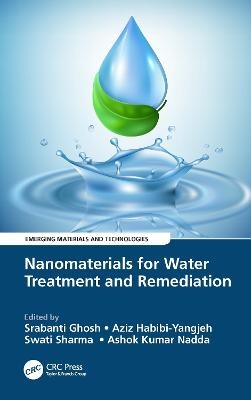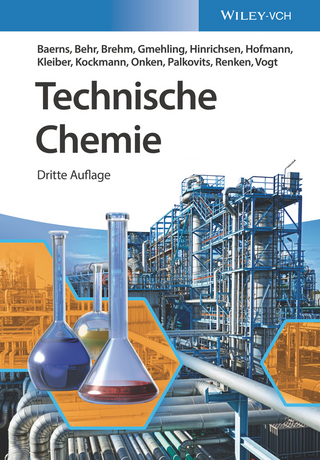
Nanomaterials for Water Treatment and Remediation
CRC Press (Verlag)
978-0-367-63307-3 (ISBN)
Offering a comprehensive view of water-treatment technologies, Nanomaterials for Water Treatment and Remediation explores recent developments in the use of advanced nanomaterials (ANMs) for water treatment and remediation. In-depth reaction mechanisms in water-treatment technologies, including adsorption, catalysis, and membrane filtration for water purification using ANMs, are discussed in detail. The book includes an investigation of the fabrication processes of nanostructured materials and the fundamental aspects of surfaces at the nanoscale. The book also covers the removal of water-borne pathogens and microbes through a photochemical approach.
FEATURES
Explains various chemical treatments for the removal and separation of hazardous dyes, organic pollutants, pharmaceuticals, and heavy metals from aqueous solutions, including adsorption, advanced oxidation process, and photocatalysis
Discusses the rational design of nanoporous materials with a tunable pore structure and fabrication of nanomaterials by surface chemistry engineering
Covers the role of nanomaterials-assisted oxidation and reduction processes, design of nano-assisted membrane-based separation, and multifunctional nanomaterials and nanodevices for water treatment
Provides an understanding of the structure–activity relationship and stability of ANMs under critical experimental conditions
Identifies potential challenges in the application of multifunctional ANMs for future research
Nanomaterials for Water Treatment and Remediation is aimed at researchers and industry professionals in chemical, materials, and environmental engineering as well as related fields interested in the application of advanced materials to water treatment and remediation.
Srabanti Ghosh received her PhD in Chemistry from UGC-DAE Consortium for Scientific Research, Kolkata Centre, and Jadavpur University, India and completed postdoctoral programs at the University of Paris SUD, France (Marie Curie Cofund). She also worked as a CSIR-SRA (Scientists' Pool Scheme) in Central Glass and Ceramic Research Institute, Kolkata, India. She worked as GOT ENERGY TALENT (GET) Cofund Marie Curie Fellow Researcher (MSCA COFUND) at the Universidad de Alcala, Spain. She has co-authored 64 publications in international scientific journals, 1 patent and 72 contributions to scientific conferences. She contributed 16 book chapters covering the large fields of polymer, nanomaterials, and photocatalysis, and edited 3 books. Her current research work is focused on nanohybrid materials, conducting polymer nanostructures for solar light harvesting, photocatalysis applications. Aziz Habibi-Yangjeh received his PhD degree in Physical Chemistry from Sharif University of Technology, Tehran, Iran, in 2001. He is currently full Professor of Physical Chemistry at the University of Mohaghegh Ardabili, Iran. His research interests include preparation of different heterogeneous visible-light-driven photocatalysts based on zinc oxide (ZnO), titanium dioxide (TiO2), and graphitic carbon nitride (g-C3N4) and their applications in different fields specially wastewater decontamination and photofixation of nitrogen. He has published more than 195 JCR papers including five review papers, nine highly cited papers, and five hot papers. Moreover, he is on the editorial board of three international journals. He contributed three book chapters in the field of photocatalysis. He has supervised more than 30 M.Sc. and Ph.D. students in Physical Chemistry. Swati Sharma has completed her PhD. from University Malaysia Pahang, Malaysia. She worked as a visiting researcher in the College of Life and Environmental Sciences at Konkuk University, South Korea. Dr. Sharma has completed her M.Sc. from Dr. Yashwant Singh Parmar University of Horticulture and Forestry, Nauni Solan H.P. India. She has also worked as a program co-coordinator at the Himalayan Action Research Center Dehradoon and senior research fellow at India Agricultural Research Institute. Dr. Sharma's research is in the field of bioplastics, hydrogels, keratin nano-fibers and nano-particles, biodegradable polymers and polymers with antioxidant and anti-cancerous activities and sponges. Ashok Kumar Nadda is Assistant Professor in the Department of Biotechnology and Bioinformatics, Jaypee University of Information Technology, India. He completed his Ph.D. in Biotechnology from the Department of Biotechnology, Himachal Pradesh University, India. He worked as a postdoctoral fellow in the State Key Laboratory of Agricultural Microbiology, Huazhong Agricultural University, China. He also worked as a postdoctoral research associate at Konkuk University, South Korea. Dr. Ashok has a keen interest in microbial enzymes, immobilization of enzymes, nanobiotechnology, biocatalysis, wastewater management, biomass degradation, biofuel synthesis, and biotransformation. Dr. Ashok has published 58 research articles, 23 book chapters, and 5 books. He is also a member of the editorial board and reviewer committee of the various journals of international repute.
1. Advancement of Nanomaterials for Water Treatment 2. Enhancement in Degradation of Antibiotics Using Photocatalytic Semiconductors under Visible Light Irradiation: A Review 3. Graphitic Carbon Nitride-Based Nanomaterials as Photocatalysts for Organic Pollutant Degradation 4. 2D Materials for Wastewater Treatments 5. TiO2-Based Nanomaterial for Pollutant Removal 6. Nanomaterials for the Removal of Heavy Metals from Water 7. Photoactive Polymer for Wastewater Treatment 8. Plasmonic Nanomaterials for Remediation of Water and Wastewater 9. Magnetic Nanomaterials for Wastewater Remediation 10. Nanofiber Membranes for Wastewater Treatments 11. Carbon Nanomaterials for Removal of Pharmaceuticals from Wastewater 12. Metal–Organic Frameworks and Their Derived Materials in Water Purification 13. Photocatalytic Mechanism in Low-Dimensional Chalcogenide Nanomaterials: An Exciton Dynamics Insight 14. Emerging Semiconductor Photocatalysts for Antibiotic Removal from Water/Wastewater
| Erscheinungsdatum | 16.01.2021 |
|---|---|
| Reihe/Serie | Emerging Materials and Technologies |
| Zusatzinfo | 17 Tables, black and white; 132 Line drawings, black and white; 38 Halftones, black and white; 170 Illustrations, black and white |
| Verlagsort | London |
| Sprache | englisch |
| Maße | 156 x 234 mm |
| Gewicht | 453 g |
| Themenwelt | Naturwissenschaften ► Chemie ► Technische Chemie |
| Technik ► Bauwesen | |
| Technik ► Umwelttechnik / Biotechnologie | |
| Wirtschaft | |
| ISBN-10 | 0-367-63307-8 / 0367633078 |
| ISBN-13 | 978-0-367-63307-3 / 9780367633073 |
| Zustand | Neuware |
| Informationen gemäß Produktsicherheitsverordnung (GPSR) | |
| Haben Sie eine Frage zum Produkt? |
aus dem Bereich


